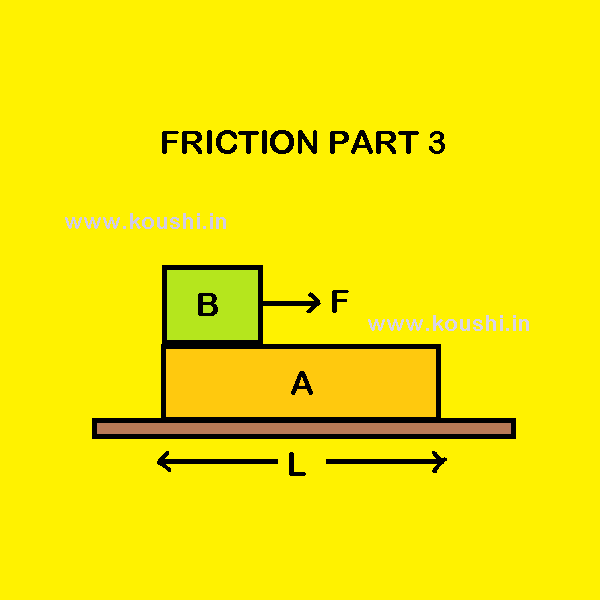A block A of mass M is placed on horizontal table. Another block B of mass m is places on block A as shown in figure. Now F force is applied on B. The conditions are explained below.

1. If there is no friction between A and B and between A and table, then B will move with acceleration aB = ![]() . There is no frictional force to move A on the table, so A remain rest.
. There is no frictional force to move A on the table, so A remain rest.
If L is the length of A, then B takes t time to fall from A. L = ![]() =
= ![]()
![]() t =
t = ![]() .
.
2. Friction presents in between A and B only and the coefficient of static friction between A and B is ![]() . The limiting friction between A and B is f =
. The limiting friction between A and B is f = ![]() mg. B will not slide on A till F < f i.e. F <
mg. B will not slide on A till F < f i.e. F < ![]() mg.
mg.
This f also acts on A by B. So, both will move with acceleration a = aA = aB = ![]() .
.
If F > f i.e. F > ![]() mg, then A and B will move in same direction but with different acceleration. The net force on B is
mg, then A and B will move in same direction but with different acceleration. The net force on B is
F – f = (F – ![]() mg). The acceleration of B is aB =
mg). The acceleration of B is aB = ![]() .
.
The net force on A is f = ![]() mg. The acceleration of A is aA =
mg. The acceleration of A is aA = ![]() .
.
3. Find the time when B falls from A: The acceleration of B with respect to A is
aBA = aB – aA = (![]() ) – (
) – (![]() ) =
) = ![]() .
.
If L is the length of A, then B takes t time to fall from A, then, L = ![]()
![]() t =
t = ![]() =
=  .
.
4. The coefficient of static friction between A and B is ![]() . Friction present in between block A and table. The coefficient of static friction between A and table is
. Friction present in between block A and table. The coefficient of static friction between A and table is ![]() . The limiting friction between A and B is f =
. The limiting friction between A and B is f = ![]() mg. The limiting friction between A and table is f/ =
mg. The limiting friction between A and table is f/ = ![]() (M+m)g. Block A will move if f > f/.
(M+m)g. Block A will move if f > f/.
The acceleration of A is ![]() =
= ![]() =
= ![]() .
.
The acceleration of B with respect to A is aBA = aB – ![]() . If L is the length of A, then B takes t time to fall from A.
. If L is the length of A, then B takes t time to fall from A.
L = ![]()
![]() t =
t = ![]() .
.
If A remain rest on the table, then the friction between A and table is f not f/. [Because friction is a self-adjusted force and if the applied force is less than the limiting friction, then the value of static friction is equal to the applied force]
Click the button to get the video explanation of this part.
